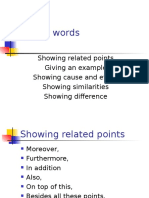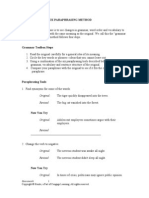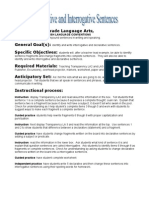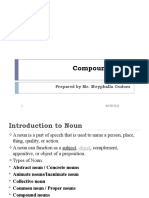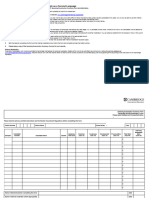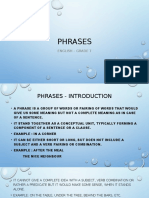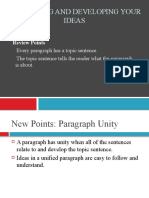Basic Sentence Patterns
Uploaded by
Janet Lyn HammondBasic Sentence Patterns
Uploaded by
Janet Lyn HammondBasic Sentence Patterns 1. S-IV (Subject + transitive verb) ~It doesnt require an object. ~I laughed. 2.
S-V-A (Subject+verb+adverbial) ~I walked along the streets of New York City. 3. S-LV-C ( Subject + linking verb + complement) ~Students from Evans are very noisy but so friendly. 4. S-TV-DO (Subj + transitive verb + direct object) ~They gave [what?who?] 5. S-TV-IO-DO ( Subj. + trans. Verb + Indirect obj + Direct obj) ~I gave Mr. Marcellano the keys to my locker for safekeeping. 6. S-TV-DO-OC (Subj. + trans verb + direct obj + obj complement) ~Students from Evans awarded Mr. Marcellano teacher of the year. Functions of Nouns Direct Obj: answers "whom" or "what" after an action verb. Prep. Complement: Indirect Obj:tells "to whom" Appositive: noun or pronoun that comes Obj of Prep: last word in a prep. phrase Predicate Nom: always renames the subject. Direct Address: to address someone Subject: Subject tells "who" or "what" about the verb. Obj Com: follows a direct object and rename it Verbals: ~a verbal is a noun, adjective or adverb form of a verb. ~Kinds of Verbals: Infinitives- TO+baseform Gerunds- -ING+nouns Participles- -D, -ED, -EN Modals: ~Modals are special verbs which behave very irregularly in English
Modal Meanings: ~EXTRINSIC-human judgement -possibility, prediction, necessity ~INTRINSIC-inner human control -permission, violation, necessity Adverb: part of speech that is primarily used to modify a verb, adjective, or other adverb. DISJUNCT:expresses the speaker or writers attitude to what is being described. ADJUNCT: Regardless of its position, an adverb is often neatly integrated into the flow of a sentence. CONJUNCT:also known as conjunctive adverb. It indicates the relationship between two independent clauses. SUBJUNCT:indicates such things as why, where, when & how. Prepositions:A preposition links nouns, prono uns and phrases to other words in asentence. The word or phrase that the preposition introduces is called the object of the preposition. -- "about," "above," "across," "after," "against," "along," "among," "around," "at," "before," "behind," "below," "beneath," "beside," "between," "beyond," "but," "by," "despite," "down," "during," "except," "for," "from," "in," "inside," "into," "like," "near," "of," "off," "on," "onto," "out," "outside," "over," "past," "since," "through," "throughout," "till," "to," "toward," "under," "underneath," "until," "up," "upon," "with," "within," and "without." Conjunctions: You can use a conjunction to link words, phrases, and clauses. COORDINATING: fanboys CORRELATIVE: always appear in pairs SUBORDINATING: introduces a dependent clause
REVIEWER IN ENGLISH
Janet Lyn A. Hammond II-Evans
Ref: Interner, Nb. :P
You might also like
- Unit 10.1 Listening Speaking Lesson PlanNo ratings yetUnit 10.1 Listening Speaking Lesson Plan2 pages
- Signpost Words: Showing Related Points Giving An Example Showing Cause and Effect Showing Similarities Showing DifferenceNo ratings yetSignpost Words: Showing Related Points Giving An Example Showing Cause and Effect Showing Similarities Showing Difference10 pages
- Adjectives: Purpose. Some of These Categories Are (Roughly in The Order in Which Adjectives Are UsedNo ratings yetAdjectives: Purpose. Some of These Categories Are (Roughly in The Order in Which Adjectives Are Used10 pages
- Sentence Patterns: English Plus (Basic Grammar)No ratings yetSentence Patterns: English Plus (Basic Grammar)21 pages
- REVIEW UNIT 789. Grade 9: B. Vocabulary and GrammarNo ratings yetREVIEW UNIT 789. Grade 9: B. Vocabulary and Grammar4 pages
- Class/Number Name:: Which Sentences Are Closest in Meaning To The Five Sentences Below?100% (1)Class/Number Name:: Which Sentences Are Closest in Meaning To The Five Sentences Below?2 pages
- The Recount Text: Click To Edit Master Subtitle Style0% (1)The Recount Text: Click To Edit Master Subtitle Style10 pages
- English Grammar I Dept. of English Letters Faculty of Letters Universitas Sanata DharmaNo ratings yetEnglish Grammar I Dept. of English Letters Faculty of Letters Universitas Sanata Dharma25 pages
- Compound Noun: Prepared by Mr. Meyphalla OudomNo ratings yetCompound Noun: Prepared by Mr. Meyphalla Oudom8 pages
- The Phrase: Recognize A When You See OneNo ratings yetThe Phrase: Recognize A When You See One8 pages
- HE Ollective OUN: Recognize A Collective Noun When You See OneNo ratings yetHE Ollective OUN: Recognize A Collective Noun When You See One6 pages
- Asking Questions in English: Write Questions For The Underlined WordsNo ratings yetAsking Questions in English: Write Questions For The Underlined Words2 pages
- Teacher's Notes IELTS Speaking Unit 10: ACCOMMODATION: Pre-Lesson ActivitiesNo ratings yetTeacher's Notes IELTS Speaking Unit 10: ACCOMMODATION: Pre-Lesson Activities2 pages
- Language Testing-Principles of Language AssessmentNo ratings yetLanguage Testing-Principles of Language Assessment15 pages
- 3 Top 20 Great Grammar For Great Writing PDFNo ratings yet3 Top 20 Great Grammar For Great Writing PDF303 pages
- Verbals, Gerunds and Participles Lesson For Middle SchoolNo ratings yetVerbals, Gerunds and Participles Lesson For Middle School18 pages
- (23-24) Misplaced and Dangling ModifiersNo ratings yet(23-24) Misplaced and Dangling Modifiers2 pages
- Organizing and Developing Your Ideas: Review PointsNo ratings yetOrganizing and Developing Your Ideas: Review Points15 pages
- Rules On Spotting Error in English GrammarNo ratings yetRules On Spotting Error in English Grammar7 pages


